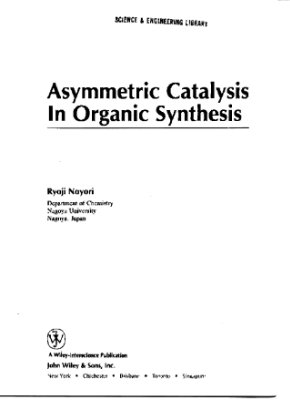Wiley , 1994. – 378 p.
This book deals with the basic principles of asymmetric catalysis and places particular emphasis on its synthetic significance. The mechanisms of most of the chemical reactions that I will discuss are obscure and are therefore treated only briefly. My talks at Coell relied heavily on chemistry developed in our laboratories at Nagoya University, and the materials in Chapters 2, 3, 5, and 6 are highly subjective. Because asymmetric synthesis with molecular catalysts is a very attractive and rich subject, many academic and industrial laboratories all over the world have contributed to its development. In an attempt to balance my coverage of the entire field, I have tried to include most of the major achievements recorded by the fall of 1992 within Chapter 4.
Most asymmetric catalyses that I will describe rely on homogeneous organometallic chemistry, but some reactions with purely organic compounds and some reactions in the heterogeneous phase are also included in Chapters 7 and 8, respectively. The collection of a range of stereoselective reactions will illustrate various strategies and methodologies as well as their general utility. I am certain that asymmetric catalysis will remain one of the most significant subjects in chemistry.
Homogeneous Asymmetric Hydrogenation
Enantioselective Isomerization of Olefins
Asymmetric Catalysis via Chiral Metal Complexes: Selected Examples
Enantioselective Addition of Organometallic Reagents to Carbonyl Compounds: Chirality Transfer, Multiplication, and Amplification
Three-Component Synthesis of Prostaglandins
Asymmetric Catalysis with Purely Organic Compounds
Heterogeneous Asymmetric Catalysis
This book deals with the basic principles of asymmetric catalysis and places particular emphasis on its synthetic significance. The mechanisms of most of the chemical reactions that I will discuss are obscure and are therefore treated only briefly. My talks at Coell relied heavily on chemistry developed in our laboratories at Nagoya University, and the materials in Chapters 2, 3, 5, and 6 are highly subjective. Because asymmetric synthesis with molecular catalysts is a very attractive and rich subject, many academic and industrial laboratories all over the world have contributed to its development. In an attempt to balance my coverage of the entire field, I have tried to include most of the major achievements recorded by the fall of 1992 within Chapter 4.
Most asymmetric catalyses that I will describe rely on homogeneous organometallic chemistry, but some reactions with purely organic compounds and some reactions in the heterogeneous phase are also included in Chapters 7 and 8, respectively. The collection of a range of stereoselective reactions will illustrate various strategies and methodologies as well as their general utility. I am certain that asymmetric catalysis will remain one of the most significant subjects in chemistry.
Homogeneous Asymmetric Hydrogenation
Enantioselective Isomerization of Olefins
Asymmetric Catalysis via Chiral Metal Complexes: Selected Examples
Enantioselective Addition of Organometallic Reagents to Carbonyl Compounds: Chirality Transfer, Multiplication, and Amplification
Three-Component Synthesis of Prostaglandins
Asymmetric Catalysis with Purely Organic Compounds
Heterogeneous Asymmetric Catalysis

